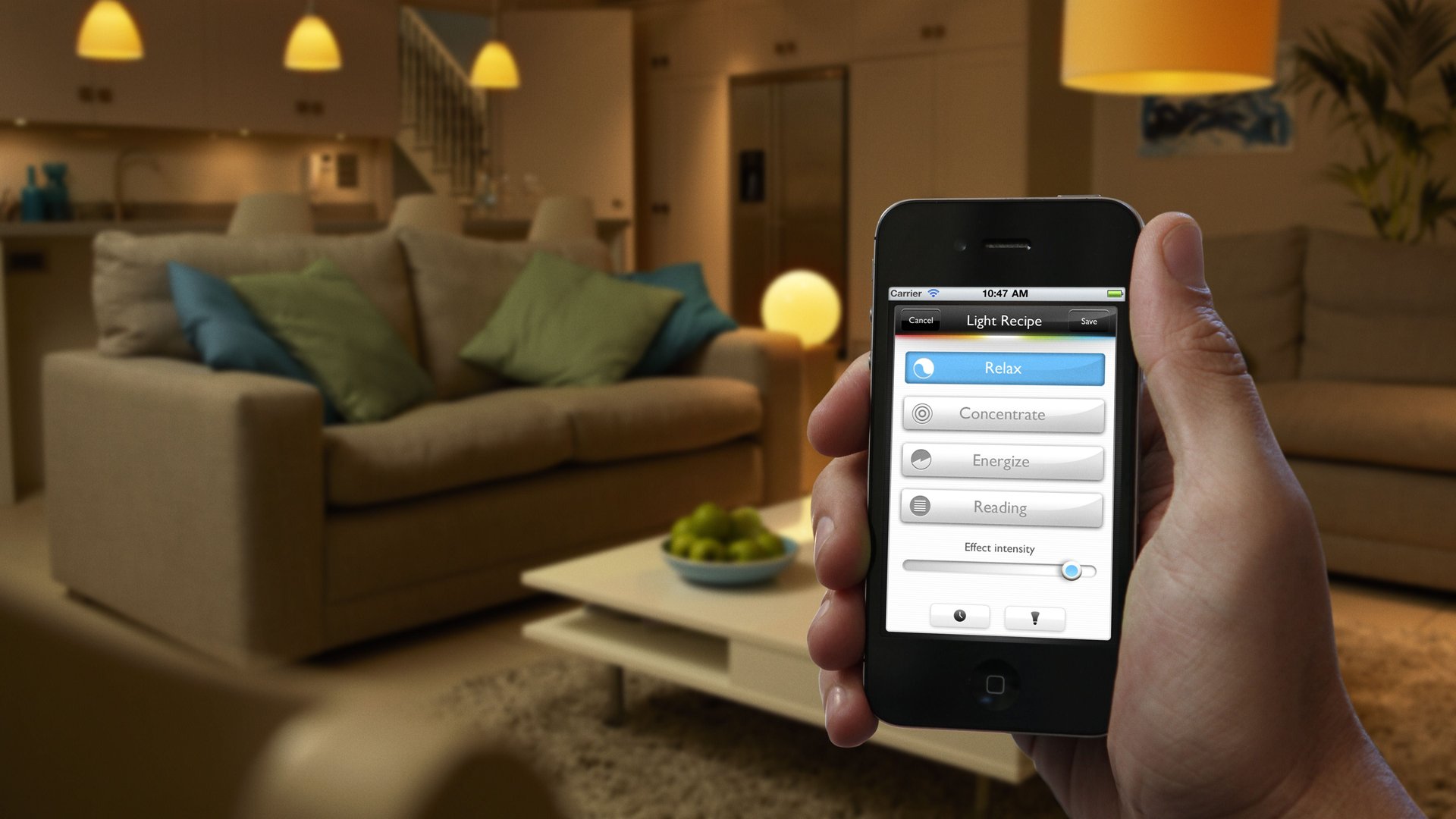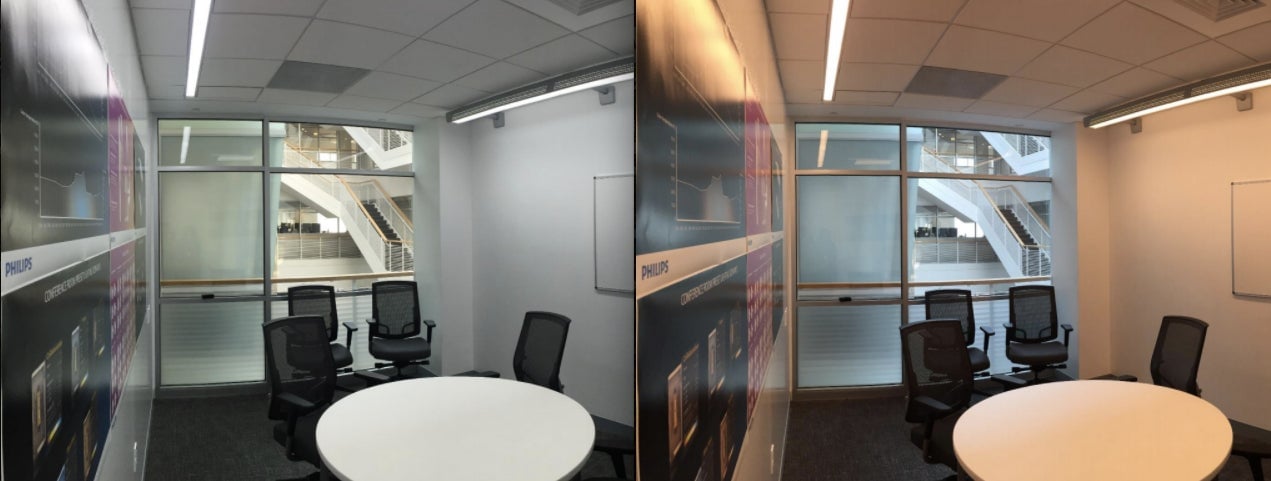Your new office lightbulbs may be hacking your circadian rhythms
A new frontier for office space wellness—a technology that some believe will make employees more alert, productive, and healthier—is already on the market for consumers. Priced at $130, the Philips “Hue White Ambiance” starter kit contains two LED light bulbs and everything you need to tweak their brightness and color temperature via a smartphone.


A new frontier for office space wellness—a technology that some believe will make employees more alert, productive, and healthier—is already on the market for consumers. Priced at $130, the Philips “Hue White Ambiance” starter kit contains two LED light bulbs and everything you need to tweak their brightness and color temperature via a smartphone.
For the price, it’s an underwhelming experience: On. Off. Dimmer. Brighter. Cooler. Warmer. Program lights to change on a schedule. More exciting is what Philips Lighting says changing light in these ways throughout the day can do for you. Inside the smartphone app that controls the lightbulbs, there are “light recipes” that, according to Philips’ website, can help you “relax with the soft glow of white light,” “stay focused with finely tuned bright white light,” and even “skip your morning coffee and get ready for the day with cool, bright white daylight that helps to energize your body and mind.”
Philips Lighting isn’t the only company to claim these types of wellness benefits from lights, but by comparison, it’s one of the more subdued.
A design firm called Glumac promises that–with the right lighting–you will experience “increased alertness in the morning,” “better concentration,” “better mood,” “reduced hyperactivity,” “reduction in errors and accidents,” and even “faster cognitive processing.” Halcyon, a brand that sells “dynamic circadian lighting,” says that this type of system has been shown by research to increase memory and promote faster cognitive processing speeds. “We know how to create lighting prescriptions to eliminate jet lag, improve sleep quality, alleviate symptoms of Alzheimer’s disease, ease depression, improve worker satisfaction, and be happier people overall,” reads the website of fixture manufacturer USAI lighting.

For more than 100 years, lightbulbs have had a pretty simple value proposition: Whether incandescent, LED, CFL, halogen, or fluorescent; low-wattage, warm, cool; round, tubular, or pear-shaped, they have been sold based on their ability to turn energy into light.
So why is light suddenly being marketed as though it’s the next miracle supplement?
Part of the answer is that scientists have recently made great strides in understanding how the human eye turns light into biological effects. Another is that, around the same timeline, LED technology has advanced to the point where it’s possible to program changes in color content and other light qualities with precision. Combining the new research with the ability to “tune” lights in order to improve human wellness seems inevitable. “It’s kind of like hacking our circadian rhythms,” a spokesperson for lighting control maker Crestron wrote in an email, referring to the system that controls physical, behavioral, and mental changes—including sleepiness—on a roughly 24-hour schedule.
But how many people are really going to pay $130 for fancy lightbulb sets? The bigger market for “human-centric lighting” that takes into account the non-visual impact of light–promising results like better focus or a good night’s sleep–is in hospitals, schools, and, lighting companies hope, your office.
Philips won nearly $500,000 from the Department of Energy in 2015 to develop an LED office lighting system that aims for both energy efficiency and “occupant health and well-being.” An early presentation of its solution involves light that changes throughout the day to mimic the sun, which tends to be bluer and brighter in the morning hours. But it also involves features that go a step beyond that. A burst of cool temperature light that mimics early morning sunshine, for instance, could help boost energy. “It’s like a caffeine-free, sugar-free coffee break,” says Meg Smith, the lighting applications specialist who runs the project. Perhaps warm-temperature could have a similar effect, she says. In the early mockups, there’s a panel for a conference room that changes the lighting between preset scenarios like “collaboration,” “focus,” “blue alert,” and “red alert” settings.

All of that sounds great, except, some scientists say, the commercialization of the technology is ahead of the actual research. “It’s decades of work, not centuries of work,” says George Brainard, a professor of neurology at Thomas Jefferson University, who has directed its light research program since 1984.
While light therapy has been developed for specific disorders like seasonal depression, bringing the same ideas into a generalized work setting comes with complicated questions for which there are only incomplete answers. What might be good for immediate job performance, for instance, could be bad for sleep later. Or vice versa. In 2013, 14 researchers from different disciplines worked together to summarize research about how light impacts human biology. They wrote that, in many ways, light can be considered a drug. “Simple prescriptions are as likely to do harm as good,” they concluded, “and even experts may have divergent ideas about best practice under some situations.” A burst of blue light might be good for people in some contexts, but disrupt their sleep in others.
So can hacking your circadian system really make you more creative? Focused? Productive? Can changing your office lighting help you sleep better?
Researchers are working on figuring out the details. In the meantime, explains one scientist, “[lighting companies] can sell pretty much whatever they want and they don’t have to do the research.”
What we know about how light impacts our bodies
We associate candlelight with “mood lighting,” bright sunny days with alertness, and cloudy days with gloominess. We’ve always known, intuitively, that there was more to light than seeing. But until relatively recently, we didn’t understand the exact biological systems that explain how light impacts us.
That began to change starting around 1980, and in 2002, researchers discovered that, in addition to rods and cones, the eye has a third photoreceptor that informs the brain about light intensity and triggers unconscious responses such as setting the circadian clock. “That dramatically increased the amount of work being done to understand the different ways light might effect different types of physiology,” says David Berson, the first author on the paper.
Another group of researchers in 2001, led by Brainard, discovered that blue wavelengths of light most impact the suppression of melatonin, a hormone that makes you sleepy and is controlled by your “master clock.” Many of the ideas about how indoor lighting can promote health come from this work. “It really opened the door for experimentation on whether or not lighting companies could, in general, come up with lighting systems that would improve overall human conditions,” says Bob Karlicek, who runs the engineering-focused Center for Lighting Enabled Systems & Applications, which is funded by the National Science Foundation, as well as corporate members.
The problem these efforts address is real. Using light at night can disrupt the circadian system. Not getting sufficient light during the day (say, because you’ve been inside an office) can make the impact of exposure to late-night light even worse. Modern office workers are susceptible to a feeling of perpetual jet lag.
Brainard’s initial findings about circadian sensitivity to blue light referred to monochromatic light, which looks blue. In other studies, he looked at the types of polychromatic light that we experience at our desks, which may have a cool color temperature but still looks white, but last year, he and a team of researchers published a paper that showed none of the models for predicting how polychromatic light will regulate melatonin, including their own model, completely worked. In general, light with a colder temperature had a bigger impact on melatonin suppression, but no model could predict that effect exactly.
Since it’s not practical to suddenly make the office light look blue at 2 p.m., any “light recipe” that claims to produce an alerting effect is therefore using more of an eyeball estimation than a precise measurement. Scientists understand that light is important to wellbeing and health: light can be effective at treating the symptoms of certain types of disorders, such as sleep disorders and seasonal depression, and being exposed to light at the wrong time, such as during the night shift at work, has correlated with heart disease, obesity, diabetes, and cancer (in other studies, it has not). The American Medical Association has, somewhat controversially, recommended against certain types of street lights in part because they contain high emissions of blue light.
Among the things scientists don’t understand is the underlying physiology of exactly how the type of light you might experience at work–white light with different color contents, at different intensities and distributions, at different times of day, for different durations–impacts different people.
“We have the hard biology to explain why these effects occur and how they occur, but not enough about how they occur in human beings where we can sit down and write you a prescription for Philips bulb 151 to make you feel [more alert or in a better mood],” Berson says.
Some of the light recipes on the market are based on extrapolations from research and intuition, rather than the solid body of literature or documented physiological effects that might be required to claim that a drug, for instance, has a certain effect. The Department of Energy has warned against making this leap. “Applying early research findings to widespread lighting practices must be done with great caution, if it is ready to be done at all,” reads a fact sheet on the topic. “After all, light as a drug is much different from light as a commodity.”
Documenting the exact biology of how light impacts people may take decades. Brainard notes that his research about how different wavelengths impact melatonin suppression “required three federal grants, a period of seven years, and doing over 700 experiments.”
Lighting companies need a big new thing
If I install an LED lightbulb in my home today, assuming I keep it on for three hours each day, I will not need to replace it again for 22 years.
That’s a big problem for the lighting industry. Companies that make lightbulbs rely on customers buying them more than once every couple of decades. Companies like Crestron that make devices that dim and automate light sell the promise of savings through energy efficiency. LEDs use so little energy that buying an expensive controller doesn’t make sense.
Large lightbulb manufacturers have dropped their lighting businesses. Siemens spun its lighting business off in 2013, Philips began the same process in 2016, and General Electric announced plans to sell its lighting business earlier this year. “They realize there’s no long-term value proposition in being a replacement lightbulb business,” Karlicek says.
GE will hang on to Current, which sells commercial LED lighting and has focused on adding value to lightbulbs by turning them into sensors that can feed information to the internet of things. Commercial and industrial LED lighting was a $39.29 billion market in 2016, according to an estimate from market research firm Grand View Research.
Health and productivity could be a lucrative use case. “If you can demonstrate that you reduce hospital stay in the ICU for half a day, that translates to so much money,” says Silvia Mioc, the director of industrial collaborations at the Center for Lighting Enabled Systems and Applications at Rensselaer Polytechnic Institute. In an office environment, demonstrating productivity is the key to getting companies to pay for human-centric office lighting. “LEDs were sold on the fact that they save energy,” Mioc says. “Whatever you save in energy is nothing compared to if you can increase productivity 1%.”
But what does productivity mean here and how do you measure it? How do you account for window light, people moving offices, and taking walks during lunch?
Color is only one of several factors in how light impacts biology. The intensity of light contributes as well. So does each person’s biology and history of light exposure. Were you up all night with the baby? Or on your iPhone? “You cannot make any claims about the benefits of daytime light exposure if you don’t know about what they’re doing in the evening,” says Mariana Figueiro, a professor at the Lighting Research Center at Rensselaer Polytechnic Institute.
Do we know enough to hack our circadian rhythms?
Lighting industry executives and some researchers argue that lighting shouldn’t be held to the same standard as a drug, especially when it’s not being used to treat a specific disorder. They believe the current biological studies as well as correlations between specific lighting conditions and effect on humans are enough proof to act on.
One of those studies showed that a “circadian lighting system” improved sleep in Alzheimer’s patients. In another field study of 109 office workers, those who received high levels of “circadian-effective light” in the morning reported that they fell asleep at night more quickly and slept better than participants who were exposed to low levels. Others show alerting effects with both blue and red light (though again, most often, using light that looks red or blue and in laboratory conditions). “I disagree that we don’t know enough,” says Figueiro. “We can and should extrapolate from research to applications. Drugs don’t have the positive effect on everyone either. Some respond to it while others don’t. While we don’t know everything about light’s effects on human health, we know enough to apply light differently than we do now.”
“The fundamental research in light and well-being is more than 20 years old,” says Philips Lighting’s Smith.”Our approach is to test and adapt systems, which can be reconfigured easily.”
Philips Lighting participates in research to validate claims of its specific products. Researchers in Hamburg, Germany and Mississippi in the US, have found better performance among students working under “focus” lighting. Another found improved sleep in hospital patients whose rooms featured human-centric lighting systems. This is obviously not the same as a body of academic literature that supports the basic biology, but for general purpose lights, Philips’ leaders argue, it’s good enough. The company isn’t claiming that its lights will cure diseases.
“If you put in this LED lightbulb, it saves 8.6% energy,” says Jeff Cassis, the head of global lighting systems at Philips Lighting. “That’s quantifiable. If you’re going to make a claim about human-centric effect, just like you would with an aspirin, [you have to understand how] it affects different patients differently, you have to be very, very precise with that. Which is why we’re careful with that sort of thing. We’re very hesitant to make any sort of medical claims, so we never do.”
But how can lighting companies be sure that there’s no negative impact from the lighting changes they put into offices and schools? “There could be that there’s no harm in an alertness boost in the afternoon,” says Jennifer Veitch, a principal research officer at National Research Council of Canada who led a committee to identify gaps in our understanding that ought to be filled before light can be considered safe and beneficial as a wellness product. “If it were the case that it somehow spilled over into home life or another aspect of wellbeing, that would not be a good thing. The problem is we just don’t know.”
John Wen, a researcher at RPI, is researching how to estimate individual circadian rhythm using biometric measurements taken by a wearable sensor. Philips’ Smith solves the problem in her DOE-funded project by keeping effects like “blue alert” to the level of individual control, so that people can choose to put on whatever lighting effect feels right for them in the moment at their desk, without impacting their neighbors, or decide together on the lighting effect in their conference room. Bursts of blue light are timed constrained to the morning (in the evening, “energy boost” settings use red light).
Though the industry argues against holding lighting systems to the standard of a drug, Smith compares what researchers know about human-centric lighting today to what researchers knew about cigarette’s role in cancer 30 years ago. “Even though the mechanisms of how cigarettes caused cancer weren’t really understood, there was enough evidence that there was a correlation that it would have been irresponsible [not to intervene.],” she says. “You can take responsible steps, even if you don’t understand exactly the mechanism, based on correlations.”
Getting people more light during the early day, in order to reduce the jet lag impact of a dark office, is something she puts in that bucket. But there’s more than one way to do that. “Going out and taking a walk during the day is the best thing you can do,” Smith says, then adds, “As long as you wear sunscreen.” She laughs. “There are no easy choices these days.”